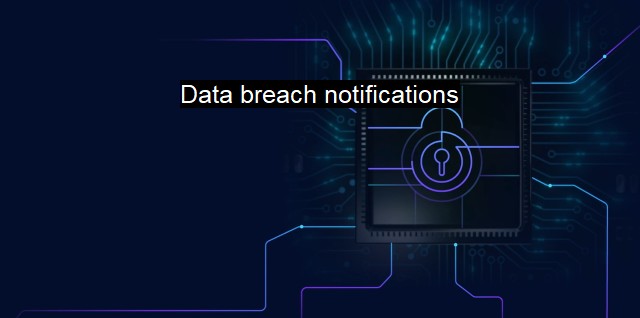What are Data breach notifications?
Mitigating Cyber Security Threats through Data Breach Notifications: Understanding the Risks of High-Tech Data Storage and Sharing in the Digital Age
"Data Breach Notification" is a fundamental concept that refers to alerting or informing affected parties about an instance of unauthorized access or disclosure of protected data. These parties usually include individuals whose personal data has been alluded and other relevant authorities, such as regulators or credit agencies. It helps ensure the practices of accountability and transparency, fiercely by cybersecurity regulations worldwide.Generally, a data breach ensues when cybercriminals gain unapproved access to a computer system or network and steal vital personal or corporate information stored therein. These breaches can perpetrate destructive reputational and financial impact on both individuals and organizations. Given these significant hazards, it is incredibly important that parties touched by these breaches are apprised of the invasion as soon as possible.
Regulatory bodies worldwide enacted several data protection directives mandating that institutions diligently notify the affected parties and bodies, supporting data breaches, within a specific timeframe. These legal requirements consistently underscore the importance of expedited and effective communication during this cliquish period. Under GDPR (General Data Protection Regulation) in Europe, for instance, an organization has 72 hours to report a breach once it becomes privy to it.
Post breach, one of the salient responsibilities of the companies is crafting a thorough, comprehensive notification. It should provide the affected ones with critical details vis-a-vis the breach, including aggregated information about what data has been breached, potential impacts and implications, appended with the proposed steps to buffer the users from such negative fallout. This notification is typically sent out in writing to ensure clarity and unambiguity, and can be supplemented by other communication channels such as email or telecommunication messages.
Varying by legal jurisdiction, these notifications may additionally have to mention suggestions like contacting credit reporting agencies, caching credit reports, and creating fraud alerts. They might also be required to emanate instructions or provisions of identity theft prevention and credit monitoring services to assist the aggrieved users. these communication documents also direct the victims in overseeing their accounts for any unsolicited activities or irate peculiarity.
In the cybersecurity landscape, antivirus plays a lead role in thwarting hackers from maliciously injecting a breach. Antiviruses often hosts a range of bolstering tools equipped with the potentiality of identifying, obliterating, and guarding against a melange of different systems threats, including malware, ransomware, and phishing attacks.
The trailblazing antivirus software programs can now swiftly detect data breaches themselves. Once the antivirus spots a vulnerable system or breach, it keeps iterating security alerts to the administer until the found irregularity or intrusion has been curtailed or dealt with. This continual notification protocol keeps the users informed, enabling them to take necessary actions proactively.
The data breach notifications act as an essential medium of communication between companies and the users whose data has been cast in the jeopardy inadvertently. It aids by ensuring the forged parties are promptly apprised of any virtual block sites, and actionable remedial measures can be smoothed or prepared to counteract and possibly sidestep the resulting collateral consequences. Against a tenaciously evolving cyber threat landscape, fostering vigilant preparedness, open discourse, and convenient adaptability with continuous virus predicted monitoring provider or schemes are key to maintaining overall cyber hygiene and integrity.

Data breach notifications FAQs
What is a data breach notification?
A data breach notification is a communication provided by a company, organization, or government agency to individuals whose personal information may have been compromised in a cybersecurity incident.What types of information are commonly included in a data breach notification?
The information typically included in a data breach notification includes the type of personal information that was compromised, the date or time range of the breach, a description of how the breach occurred, and steps that individuals can take to protect themselves from identity theft or other malicious activities.What are the legal requirements for data breach notifications?
The legal requirements for data breach notifications vary depending on the state or country in which the breach occurred. In general, organizations are required to notify affected individuals as soon as possible after discovering a breach, and may also be required to notify regulatory agencies or law enforcement. Failure to comply with these requirements can result in significant fines or other penalties.How can I protect myself from the effects of a data breach?
There are several steps you can take to protect yourself from the effects of a data breach, including monitoring your credit reports and financial accounts regularly, using strong passwords and two-factor authentication, and being cautious about sharing personal information online. It is important to remember that no security measure is foolproof, so it is always wise to be vigilant and take prompt action if you suspect that your personal information has been compromised.| | A | | | B | | | C | | | D | | | E | | | F | | | G | | | H | | | I | | | J | | | K | | | L | | | M | |
| | N | | | O | | | P | | | Q | | | R | | | S | | | T | | | U | | | V | | | W | | | X | | | Y | | | Z | |
| | 1 | | | 2 | | | 3 | | | 4 | | | 7 | | | 8 | | |||||||